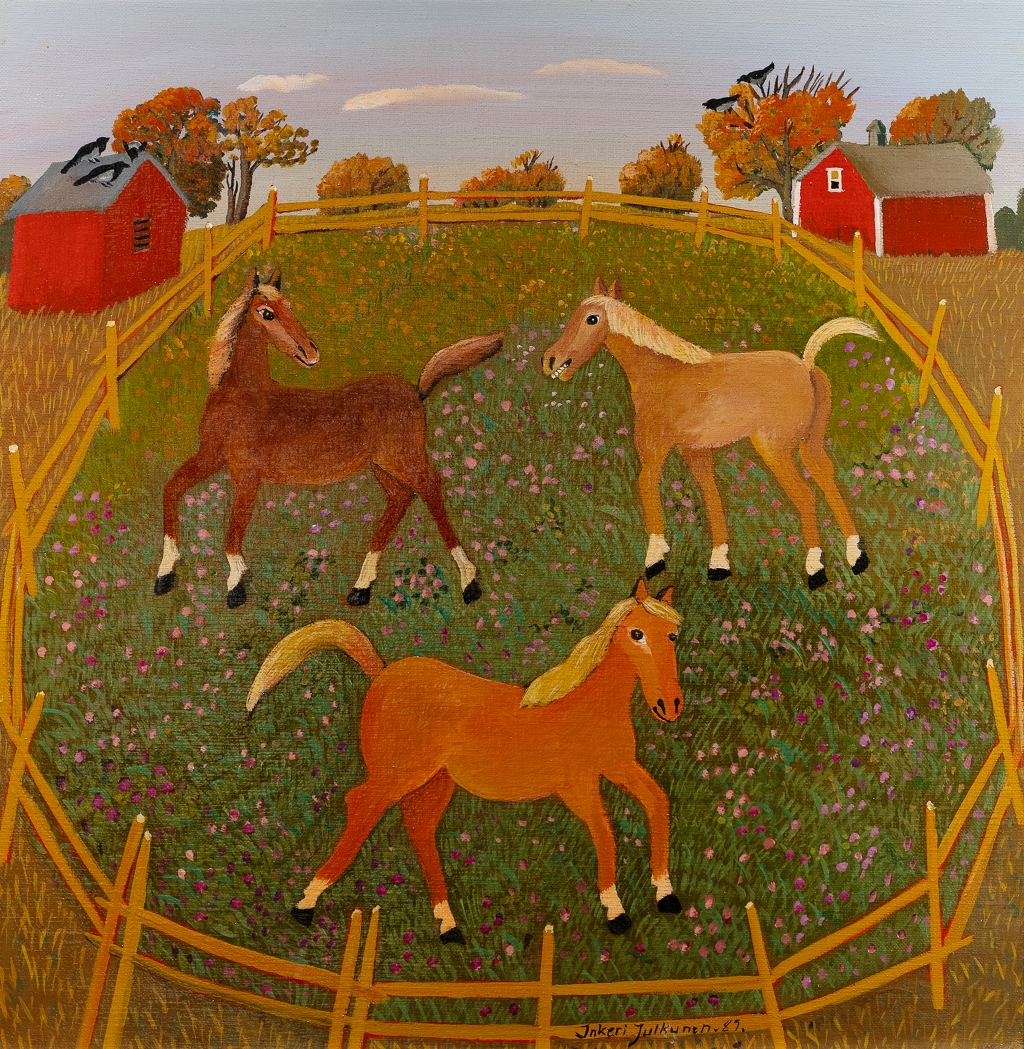
Article categories: Archive News
Inkeri Julkunen and Other Naïve Artists – this summer, the Ostrobothnian Museum will host an exhibition dedicated to Finnish naïve art
Published: 6.6.2025
In June, the Ostrobothnian Museum will open an exhibition showcasing naïve art, with a special focus on Vaasa-born artist Inkeri Julkunen (1935–2017). The many faces of naïve art are also explored through works by Julkunen’s contemporaries. This comprehensive exhibition is, for the first time, bringing naïve art into broader focus as an artistic movement in Vaasa’s museums.
Inkeri Julkunen (1935–2017), a self-taught artist from Vaasa, began painting in the early 1970s. She was drawn to naïve art, as it appealed to her and seemed to suit her best.
Naïve art is a highly multifaceted artistic style, encompassing a wide variety of themes, techniques, and approaches. The exhibition at the Ostrobothnian Museum highlights this artistic movement particularly through the work of Inkeri Julkunen. The exhibition showcases her work from the 1970s through to the 1990s, featuring primarily oil and acrylic paintings, along with selected sculptures.
The exhibition offers insight not only into Julkunen’s body of work but also into the diversity of Finnish naïve art, featuring paintings by some of the country’s leading naïve artists, including Martti Innanen (1931–2014), Alice Kaira (1913–2006), Lea Kauppi (1917–1999), Pirkko Lepistö (1922–2005), and Tuomas Mäntynen (1932–2024) They all represent a period during which naïve art gained a foothold in Finland.
A warm-hearted chronicler of everyday life
Inkeri Julkunen was born in Vaasa in 1935 and spent most of her life in Karperö with her husband, photographer Mikko Julkunen. At around the age of 30, she began painting as a self-taught artist, first using oil paints and later switching to acrylics. She drew inspiration from her immediate surroundings, painting from memory, sketches, or direct observation. At times, she also used her husband’s camera as a tool. As Julkunen often depicted her local surroundings, familiar landscapes and views from Vaasa and Karperö have been preserved in her works.
Alongside street scenes, Julkunen’s works also feature glimpses of everyday chores, friends, neighbours, and the occasional passers-by. For instance, in the painting Convenience Store, 1977, we see Ann-Mari Lammio’s colonial goods shop in Vaasa. Julkunen received considerable praise for that particular piece. She was seen to capture the spirit of a bygone era through a kind of naïve realism.
Animals played an important role in Inkeri Julkunen’s life – she was a prolific painter or both the family’s and the neighbourhood’s animals. Works such as Black sheep, 1988 and Mirre,1986 reflect her love of animals and her keen eye for detail.
Contemporaries highlighted
Naïve artists are often self-taught, like Inkeri Julkunen, though the movement is not limited by educational background. What unites them is a humane, warm, and at times melancholic approach to life. Naïve art can be both playful and socially engaged at the same time.
Depictions of everyday life are common in the naïve painting style. The house and home are also recurring themes. Buildings are often placed centrally and close to the foreground, in the frontal manner typical of the naïve style. Often, there is a path leading up to the house. Everyday life is also a recurring theme in the works of Martti Innanen, Lea Kauppi, and Pirkko Lepistö, although Innanen’s portrayals of everyday life often carry a more satirical and humorous tone than Julkunen’s.
‘I’m a naïvist, and I dare say I always will be’
Inkeri Julkunen took part in several group exhibitions in Finland, beginning in 1972. She had her first solo exhibition in 1977, and between 1989 and 1993 she took part in the Naivistit Iittalassa (‘Naivists in Iittala’) exhibitions. Her works were also shown in group exhibitions in Sweden, including in Malmö, Sundsvall, and Örnsköldsvik. She was a member of several associations and artists’ unions, including the Finnish Painters’ Union, the Vaasa Artists’ Guild, as well as local Ostrobothnian artists’ associations.
Julkunen’s early works show a somewhat more subdued colour palette, whereas her paintings from the 1980s are more vibrant and make extensive use of complementary colours. She was clearly fascinated by the changing light and colours of the sky. According to her, her paintings were ‘half true and half fiction’. The works now on display in the exhibition are representational, with a few pieces standing out for their strong imaginary elements. Julkunen was navigating in the space between art and reality. As she herself put it: ‘I am a naïvist, and I dare say I always will be.’
Information about new works is still welcome
Naïve art as an artistic movement has not previously been widely presented in Vaasa Museums. In 2024, the museums launched a project to document and survey Inkeri Julkunen’s body of work. At the outset, the museum held eight works in its collection, and the survey revealed a substantial number of additional pieces. It is likely that more artworks exist which have yet to be found and identified. We are still happy to receive information about Inkeri Julkunen’s works. Please send any information to Museum Curator Janna Sirén at janna.siren@vasa.fi.
The exhibition will be on view at the Ostrobothnian Museum from 7 June to 19 October 2025.
